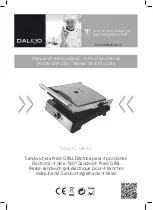
74
Here are a few ways to extend battery life between charges:
Use the back-lighting only when it is strictly necessary,
Set the brightness of the back-lighting to the lowest level at which you can still read the display unit,
Use the back-lighting only as long as you must (see SET-UP, § 5),
Program the shortest time to automatic switching off you are comfortable with (see SET-UP, § 5),
Use the pulse mode for continuity measurements at 200 mA,
If the continuity measurement at 200 mA is made in permanent mode, do not let the measurement leads touch each other
when you are not making a measurement,
When making insulation measurements at high test voltages, stop pressing the
TEST
button when the measurement is over.
6.5.5. “BATTERY REACTIVATION” MESSAGE
When a battery is deeply discharged or its storage temperature is low, the charger may execute a prior battery reactivation cy-
cle. That means that the charger applies a slow charge until the battery reaches either a minimum temperature threshold or a
minimum charge threshold.
If the battery is in good condition, this reactivation stage ends after about 45 mn and the charger switches over to fast charging.
If, however, the maximum time allowed for the qualification stage is exceeded, the device declares the battery defective and
displays a message on the screen of the measuring device.
In this case, we recommend proceeding as follows:
Remove the battery compartment cover (voir §8.2),
Disconnect the battery connector,
Wait approximately 10 seconds,
Reconnect the battery connector to the device,
Put the battery compartment cover back in place,
Charge the battery once more.
If charging proceeds normally, let the device perform a full charge.
If, at the end of some time, the “defective battery” message appears once again, the battery must be replaced.
6.5.6. ENF OF BATTERY LIFE
The internal resistance of a battery at the end of its life is high. The result is an abnormally short charging time.
After a full charge, the device indicates “charging over”, but as soon as the charger is disconnected, the display unit loses its
contrast and goes off, meaning that the battery no longer holds a charge.
Before you replace the battery, we recommend referring to § 6.5.5 and performing the procedure indicated.
6.6. ENVIRONMENTAL CONDITIONS
Indoor and outdoor use.
Operating range
0 to 55°C and 10% to 85% RH
Specified operating range
13
0 to 35°C and 10% to 75% RH
Range for recharging the battery
10 to 35°C
Range in storage (without battery)
-40°C to +70°C and 10% to 90% RH
Altitude
<2,000m
Pollution degree
2
13: This range corresponds to the range of the operating uncertainty defined by standard IEC-61557. When the device is used
outside this range, it is necessary to add 1.5%/10°C and 1.5% between 75 and 90% RH to the operating uncertainty.
6.7. MECHANICAL CHARACTERISTICS
Dimensions (L x D x H) 280 x 190 x 128 mm
Weight
approximately 2.4 kg
Protection class
IP 53 per IEC-60 529.
IK 04 per IEC-50102
Free fall test
Per IEC-61010-1









































